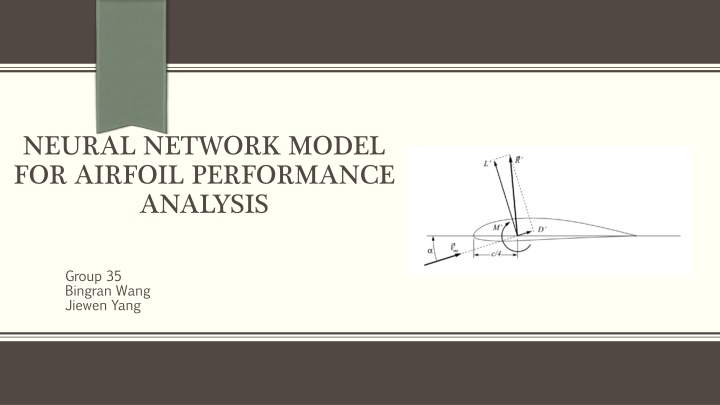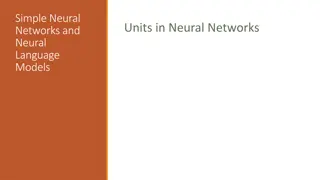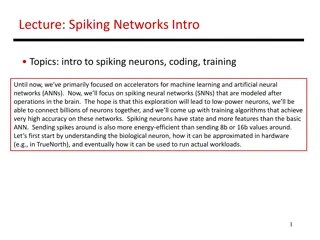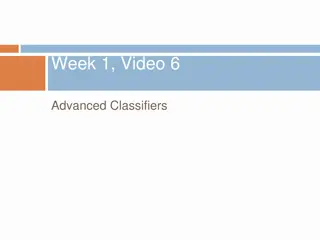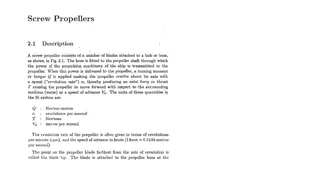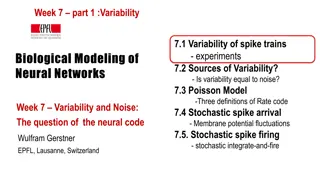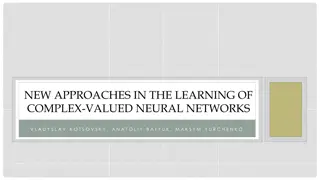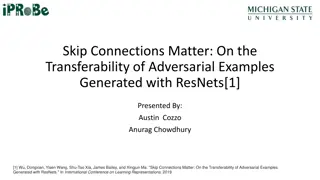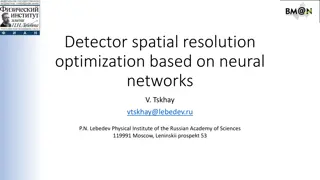Efficient Airfoil Performance Analysis using Neural Networks
Airfoil performance analysis is crucial for aircraft design, with current methods relying on expensive CFD solvers. This project explores a neural network model for analyzing airfoil performance efficiently, benefiting from dimensionality reduction and surrogate modeling. The dataset consists of 1600 airfoil shapes with corresponding aerodynamic characteristics, extracted and selected features to enhance analysis accuracy.
Download Presentation

Please find below an Image/Link to download the presentation.
The content on the website is provided AS IS for your information and personal use only. It may not be sold, licensed, or shared on other websites without obtaining consent from the author.If you encounter any issues during the download, it is possible that the publisher has removed the file from their server.
You are allowed to download the files provided on this website for personal or commercial use, subject to the condition that they are used lawfully. All files are the property of their respective owners.
The content on the website is provided AS IS for your information and personal use only. It may not be sold, licensed, or shared on other websites without obtaining consent from the author.
E N D
Presentation Transcript
NEURAL NETWORK MODEL FOR AIRFOIL PERFORMANCE ANALYSIS Group 35 Bingran Wang Jiewen Yang
Background Airfoil is the cross-sectional shape of a wing Analyzing the aerodynamic performance is important for aircraft designs. Current airfoil analysis relies on high-fidelity Computational fluid dynamic (CFD) solvers. High-fidelity CFD solvers are very expensive to run. For design optimization, an efficient analysis method is important! Fig. 1, Different Airfoil Shapes
Background Performance of an airfoil is measured by Cl, Cd, Cm. Cl, Cd, Cm are determined by Airfoil Shape Mach Number (M) Reynold Number (Re) Angle of Attach (Alpha) Fig. 2, Airfoil Characterization Cl, Cd, Cm = f (Airfoil Shape, M, Alpha, Re)
Literature Review Two approaches to construct an efficient airfoil model: Dimensionality Reduction [1]: Reduce Design Variables: Principal Component Analysis Partial Least Square Advanced shape parametrization: Non-uniform rational B-spline [2] Surrogate Model [3] [4] Radial Basis Function Gaussian Regression Process Neural Network [5]
Advantages of Neural Network Dimensionality Reduction Model Lose part of the information as a trade-off Not cheap to run it. Typical Surrogate Model Can hardly deal with large data Neural Network Surrogate Model Deal with large data High-accuracy Cheap to evaluate
Dataset The dataset is generated by two steps Step 1 1600 Airfoil Shapes are downloaded from UIUC Airfoil Coordinate Database. 251(x, y) points to represent one airfoil shape. Step 2 Run CFD solver for each airfoil under different conditions to generate corresponding cl, cm, cd. Alpha= linspace(-4.25, 15.75,0.25). Mach = linspace(0.16,0.60,0.04). Re = (3000000, 6000000, 9000000). Overall: 5,000,000 x 505 inputs, 5,000,000 x 3 outputs. Fig. 3, UIUC database description
Feature Extraction & Selection Feature extraction is a process of dimensionality reduction by which an initial set of raw data is reduced to more manageable groups for processing Selection: Head point and Trail Point are the same for all airfoils (x1,y1) = (0,0), (x251,y251) = (0,1) Dropout regularization Prevent overfitting (dealing with data difference within E-4 scale Dense Regularization 505 features to 100 features
Neural Network Model Neural network surrogate model is constructed as: 1. Preprocess the input parameters with MinMaxScalar. 2. 10-hidden-layer neural network with ReLu function. 3. Set the cost function as RMSE between. RMSE gives a relatively high weight to large errors. 4. Train the model using Adam optimizer. Fig. 3, Neural Network Structure
Results Airfoil AG34, Re = 3,000,000:
Further To Do Include more data and tune the model to maker a better fit Generate the model for Cd, Cm. Make more comprehensive plots to demonstrate the results.
Reference [1] Van Der Maaten, Laurens, Eric Postma, and Jaap Van den Herik. "Dimensionality reduction: a comparative." J Mach Learn Res 10.66-71 (2009): 13. [2] Masters, Dominic A., et al. "Geometric comparison of aerofoil shape parameterization methods." AIAA Journal (2017): 1575-1589. [3] Chaudhuri, Anirban, et al. "Reusing Information for Multifidelity Active Learning in Reliability-Based Design Optimization." AIAA Scitech 2019 Forum. 2019. [4] Koziel, Slawomir, David Echeverr a Ciaurri, and Leifur Leifsson. "Surrogate-based methods." Computational optimization, methods and algorithms. Springer, Berlin, Heidelberg, 2011. 33-59. [5] Du, Xiaosong, Ping He, and Joaquim Martins. "A B-Spline-based Generative Adversarial Network Model for Fast Interactive Airfoil Aerodynamic Optimization." AIAA Scitech 2020 Forum. 2020.
